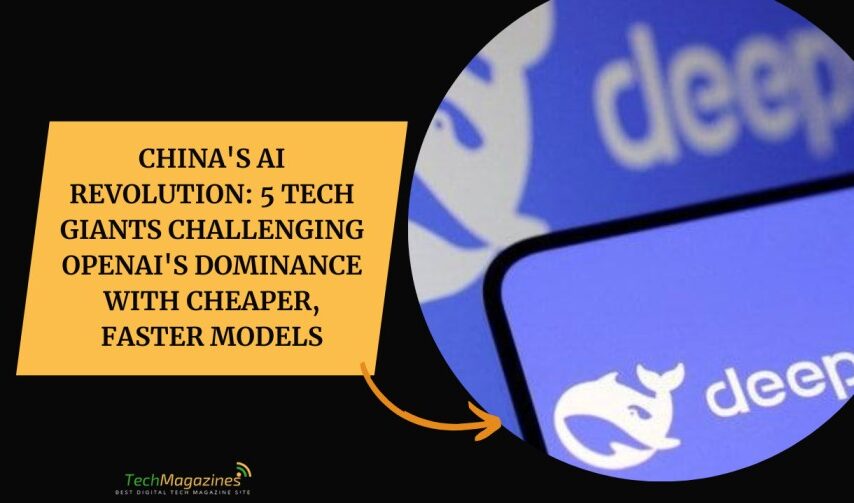DeepSeek unleashed an AI model. It rivaled OpenAI’s o1 but cost far less. Investors were shaken. Markets staggered. Nvidia, the mighty chipmaker, lost over $500 billion in a single day—Wall Street’s worst drop ever. Fear gripped investors. DeepSeek threatened America’s AI dominance.
Donald Trump called it a “wake-up call.” In China, DeepSeek’s founder, Liang Wenfeng, was a hero. The people cheered. The government embraced him. Premier Li Qiang summoned him to a grand symposium. China was catching up. Fast.
NVIDIA has reported a historic slump in market value following the rise of DeepSeek AI https://t.co/oejwp7PqQC
— GLITCHED (@_GLITCHED_) January 28, 2025
But DeepSeek was not alone. Other Chinese firms broke through despite U.S. sanctions. One after another, they revealed AI models as strong as OpenAI’s, as powerful as DeepSeek’s. The race was on. And China was no longer behind.
5 Tech Giants Challenging OpenAI’s Dominance with Cheaper, Faster Models
1. Alibaba Cloud
On January 29, the first day of the Lunar New Year, Alibaba Cloud made its move. The tech giant, a branch of Alibaba, launched Qwen 2.5-Max, an upgraded AI model.
Alibaba Cloud claimed victory. Qwen 2.5-Max beat DeepSeek V3 and Meta’s Llama 3.1 in 11 benchmarks. The company brimmed with confidence. The next version, they said, would be even stronger.
Some analysts saw urgency. DeepSeek had shaken the market, and Alibaba Cloud felt the heat. Others, like Sheehan, thought different. Maybe it was strategy. Maybe they wanted to ride DeepSeek’s wave while it was still high.
2. Zhipu
🚀 AutoGLM is an AI Agent browser extension launched by Zhipu in Oct 2024. AutoGLM-Web, a browser extension powered by AutoGLM, can perform tasks on browser with simple commands! Now supports auto-searching, summarizing info, commenting, liking, and even writing articles.
— ChatGLM (@ChatGLM) January 24, 2025
Best… pic.twitter.com/QOjIHepvSs
Zhipu is a Beijing start-up. Alibaba backs it. One of China’s “AI tigers,” it made headlines. Not for its AI. Not for its breakthroughs. But for being blacklisted by the U.S. government.
On January 15, the U.S. added Zhipu to its restricted trade list. More than two dozen Chinese firms were named. The charge? Helping China’s military with AI. Zhipu denied it. Called it baseless.
Politics aside, Zhipu moves fast. In October, it launched AutoGLM, an AI assistant. It lets users control smartphones with complex voice commands. The race continues.
3. Moonshot AI
Kimi k1.5: The Multimodal Reasoning Model
— Kimi.ai (@Kimi_Moonshot) January 26, 2025
– Available now on https://t.co/7YeIld97BT 🦄
💡 What can Kimi k1.5 do?
🔹 Image to Code: Convert images into structured code and insights
🔹 GeoGuessr: Identify and pinpoint locations in geography games like a pro 🌍
🔹 Visual… pic.twitter.com/LEnTC4zZRL
Moonshot AI is a Beijing start-up. After its latest funding round, it’s worth over $3 billion. It says Kimi k1.5 is strong. As good as OpenAI’s o1. Maybe better. O1 thinks longer. Solves harder problems. But Moonshot claims Kimi wins in math. In coding. In understanding words, images, video. If true, it’s a challenge. A real one.
4. ByteDance
On January 29, another player came to the scene. TikTok’s parent company, ByteDance, has introduced Doubao-1.5-Pro. An upgrade. Some claimed that it could outperform OpenAI’s o1 on some of the benchmarks. It wasn’t just power. It was price. Chinese companies were cutting deep. Doubao’s strongest version cost 9 yuan per million tokens. Nearly half of DeepSeek-R1’s price. OpenAI’s o1? A steep 438 yuan for the same use. The message was clear. China wasn’t just catching up. It was changing the rules.
5. Tencent
Tencent is known for gaming. For WeChat. The application that is used by a large number of individuals in China. But it has moved into AI too. Its flagship model is Hunyuan. A text-to-video generator. Tencent stated that it can compete with Meta’s Llama 3.1. Some say it did it with a fraction of the power. A tenth of what Meta used. Efficient. Fast. Powerful. Tencent is in the race.
Conclusion
As China’s AI race intensifies at a pace faster than the overclocked GPU, it is evident that DeepSeek has triggered a gold rush in the Middle Kingdom. Where there was once doubt that Chinese AI is nothing more than clones, today these companies are setting high standards in terms of performance and cost. The real winner? Competition itself is a wonderful thing – as this artificial intelligence arms race brings about new technologies and cheaper prices. The only question that remains: Which of the Chinese AI firms will be the next one to make Wall Street sweat?
FAQs
Q1: What’s the big deal about DeepSeek, and why did it cause such a stir?
A: Imagine this: A Chinese firm comes from the blue and develops an AI model that performs as well as OpenAI but costs significantly less. The result? It was a Black Thursday for Wall Street with Nvidia shedding $500 billion in market value in a single day – the largest ‘whoopsie’ in the stock market.
Q2: Are these Chinese AI companies actually innovating, or are they just playing catch-up?
A: Unlike the traditional Chinese companies that were associated with cheap products in the past, these firms are stretching the limits more than a postman on coffee. For instance, there is Moonshot AI’s Kimi model that can handle 2 million Chinese characters, which is equivalent to reading “War and Peace” several times. They are not only matching up, but in some areas, they are outrunning their counterparts in terms of the price-performance ratios.
Q3: Why are Chinese companies releasing their AI models during the Lunar New Year?
A: When Alibaba Cloud released Qwen 2.5-Max during the holiday, it was either feeling the heat from DeepSeek’s success or trying to crash the party while everyone is busy with dumplings and red envelopes. This is something that many people do not like to do, working through the holidays in order to keep up with the AI Joneses.
Q4: What’s the deal with all these companies being backed by Alibaba?
A: Alibaba is acting as an AI venture capital like it is the only person at a buffet where one can invest in as many ventures as they want. They are supporting everyone from the incumbent players to the new entrants into the market such as Zhipu and Moonshot AI. It is their approach to make sure that they remain relevant in every kind of AI, even if they are not sure of which one will be the next popular one.








